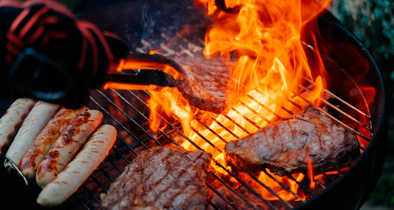
In preparation for July 4th, or as we know and LOVE, Independence Day, this Kapers article will start with a mini-lesson about a favorite meat: Pork.
I have borrowed The Barbecue Bible, from Libby, which is one of the greatest apps available (in my humble opinion) where you can borrow e-books at your public library for offline reading, to read any time, anywhere. I used to buy e-books until my friend Susan challenged me to “try it, you’ll like it!”
I did, and I do! And I save a ton of money because I am a voracious reader!
Although the term “barbecue,” has been enlarged in these modern times to include the direct application of dry heat or hot fire, for just a few minutes, as when we grill the food over hot coals or a gas fire out on our patio with friends and family, the original meaning of the word “barbacoa” refers to an ancient cooking method that uses live fire and smoke to cook the food at low temperatures over a period of many hours; it results in a very tender and tasty meat, and the method is still used today in many different cultures, including our own.
It dates back to the middle ages, but, in North America, probably began with the Taino people of the Caribbean, and was subsequently brought here by the Spanish. They also brought with them (to our everlasting good fortune), vinegar and pigs! As exploration turned to Colonialism, this unique way of cooking spread quickly among the Spanish, French, and English colonists, particularly in the south.
So, back to The Barbecue Bible. It is written by Steven Raichlen and reputed to be (by Esquire) “The most extensive collection of (barbecue) recipes and techniques… ever published.” It was the winner of The Julia Child Cookbook Awards, International Association of Culinary Professionals.
Barbecue, as we use the term in our culture as it applies to the slow cooking of meat, covers four different styles: Carolina; Kansas City; Memphis; and Texas, I will start with Carolina barbecue.
What’s the difference between a whole pork shoulder, a picnic shoulder, and a Boston butt?
A whole pork shoulder, cut from the front end of the hog, is a large rectangular hunk of meat, generously marbled and weighing twelve to fifteen pounds, It comprises two pieces: the picnic shoulder (sometimes called a picnic ham or shank end of the shoulder) and the Boston butt.
The picnic shoulder is the foreleg end of the shoulder and it often contains the top of one of the forelegs. This gives it an interesting shape and flavor; some pit masters swear by it.
The Boston butt is the back part of the shoulder – it’s more block-like in shape and has a higher ratio of meat to skin or bone. It is the preferred cut for most enthusiasts of North Carolina-style pulled pork.
Should you pull or chop a pork shoulder?
First thing you need to know, if you’re NOT familiar with Carolina-style pit-roasted pork shoulder, is that it is always served pulled or chopped.
Pulled refers to meat that’s been torn into fine shreds by hand, while chopped indicates meat that has been reduced to a hash-like consistency with a cleaver.
Pulled is how you get pork at barbecue competitions and at Carolina pig pickings, where a whole hog is pulled into meaty shreds to be doused with thin spicy vinegar sauce.
Chopped is how the pork is generally served at restaurants. Pulling has the advantage of having been graced with a human touch, while chopped pork often contains “brownies” – crisp bits of chopped crust and skin. A few establishments, particularly in South Carolina, serve their pork shoulder thinly sliced.
And which sauce – vinegar or mustard?
The traditional sauce of North Carolina is vinegar sauce, a watery condiment made from distilled vinegar, salt, pepper, hot pepper flakes, and perhaps a little brown sugar to cut the edge. That’s how they make it in the eastern part of the state.
In the western part, they often add a little ketchup. The result is a tart, pugnacious sauce that has absolutely nothing in common with the sweet, thick, tomato-based barbecue sauce slathered on ribs in Kansas City (and in most of America). The fact is, you wouldn’t really want to eat a vinegar sauce by itself. But mix it into pulled or chopped pork and it homogenizes with and counter-balances the fat, giving you one of the most perfect pork and sauce combinations in the world.
The preferred sauce in South Carolina is mustard sauce, made by combining mustard (usually ballpark style) with vinegar and sugar or honey. It, too, is wonderful, and I’d have to taste several hundred more servings of both types of sauces in a comparative tasting to be able to pronounce one or the other my favorite.
What’s better: spareribs or baby backs?
It’s a matter of taste. Spareribs are bigger and tougher, but they’re loaded with meaty flavor. Baby backs are more tender and better marbled, and they’re also a lot quicker and easier to cook. Most people prefer baby backs. My suggestion is, if you’re new to this game, start with baby backs. You can always graduate up to spares.
What are rib tips?
Rib tips are the cartilaginous ends of spareribs; they are often cut off and packaged with the spares. At least one pit master, Lindsay Shannon of BB’s Lawnside BarB-Q in Kansas City, has made them a house specialty. Smoke rib tips low and slow as you would spareribs.
What’s the easiest way to remove the “skin” on the back of a rack of ribs?
The “skin” is a papery membrane (technically known as the pleura) found on the inside or concave side of a rack of ribs. The easiest way to remove it is to loosen it from a couple of the ribs by inserting a slender metal object, like the tip of an instant-read meat thermometer or a clean Phillips head screwdriver, under the membrane, then prying it away from the bones. Once you have the membrane loosened, grab it with a dry paper towel or dishrag (the membrane is slippery) and pull it away from the rack.
The skin comes off of baby back ribs very easily; you need to work a little harder to remove it from spareribs and beef ribs.
Why bother? First, because the skin is a little tougher than the rest of the meat. And second, because if you leave the skin on, it impedes the absorption of spice and smoke flavors.
Following your recipe, I made ribs that had a dry rub applied first, then a mop sauce, then barbecue sauce. Did I wash off the rub with the mop sauce? Should I spray the mop sauce on next time?
The mop sauce goes on after the first forty-five minutes or so of cooking, which gives the meat ample time to absorb the rub first. The mop sauce combines with any rub that has not been absorbed to create a spicy paste that cooks into the meat, producing a savory crust. However, mop sauces should be applied with a light touch – not slopped on by the bucketful. You can certainly switch to a spray bottle. Incidentally, many pit masters spray ribs or pork shoulders with pineapple juice or apple cider.
No matter how closely I watch my ribs, they always seem to burn after I put the barbecue sauce on. What am I doing wrong?
Most barbecue sauces contain a lot of sugar, and if you apply them too early, that sugar will burn before the meat is actually cooked. I almost always cook my ribs without sauce, serving the sauce on the side. If you do want to glaze the ribs with sauce, do so during the last three to five minutes of cooking.
Why won’t my ribs come out fall-off-the-bone tender?
Because you have the wrong set of expectations. A properly cooked rib should be tender, of course, but it should also have a little chew to it – that’s why God gave you teeth. You should be able to gnaw the meat off the bone. Fall-off-the-bone-tender ribs have been boiled or braised in the oven, and in my barbecue religion, that’s heresy.
Should I boil, bake, or microwave ribs before grilling?
Absolutely not. You can achieve the requisite tenderness by smoke roasting the ribs on a grill or in a smoker.
I made ribs for the first time, and they turned out great. But I noticed there was a pinkish ring in the meat. Did I do something wrong?
On the contrary: You should pop open a bottle of Champagne (or microbrew) and celebrate. The pinkish ring is the smoke ring – a natural chemical reaction that takes place when meats are cooked low and slow in the presence of abundant wood smoke. Pit masters call it a “red badge of honor” (with apologies to Stephen Crane), and it lets you know you’ve smoked the ribs (or brisket or pork shoulder) to perfection.
